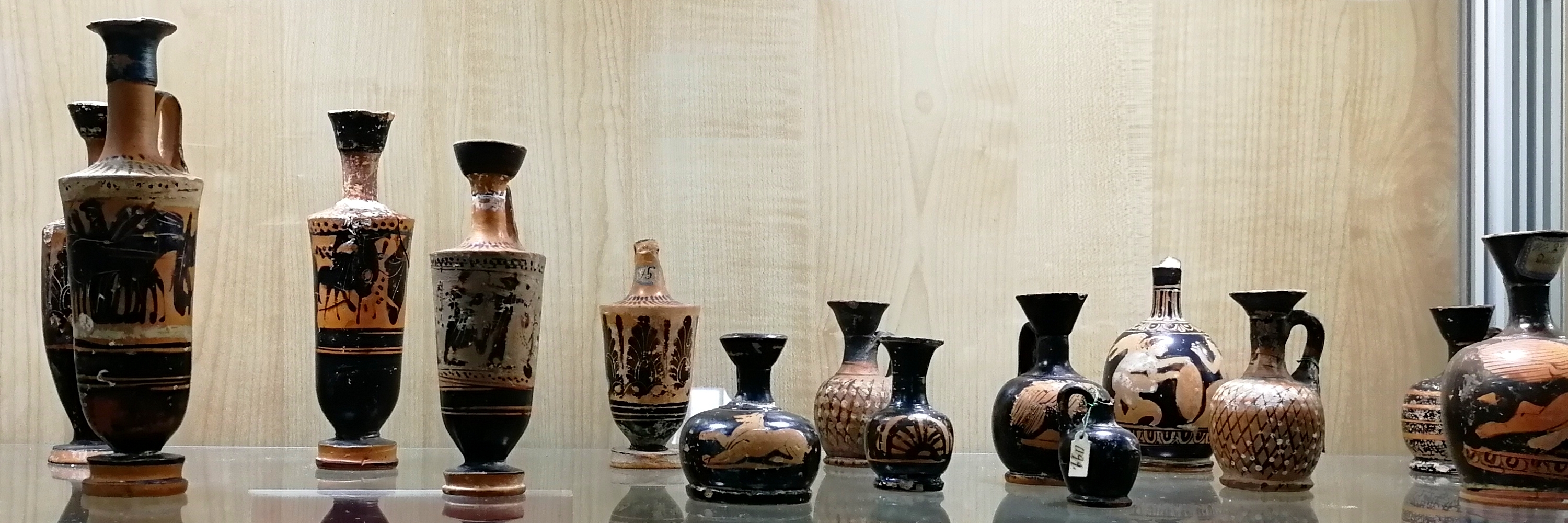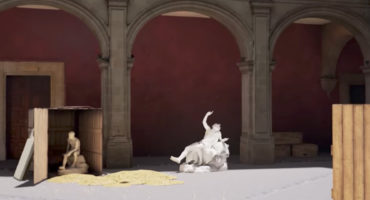Background
Cultural heritage digitization at Perm University became possible due to the collaboration of the Center for Digital Humanities and the Perm University History Museum.
The project team has an interdisciplinary background and is represented by historians, digital humanities specialists and museum workers who are open to active dialogue and using information technologies to enable wider involvement and recognition of cultural heritage in science, education, art and other fields. The project team is represented by experienced researchers – professor Sergey Kornienko, associate professor Nadezhda Povroznik, associate professor Maria Romashova, Perm University History Museum deputy director Elena Tararukhina, as well as a younger generation – graduate student Iliana Ismakaeva, and college student Arkady Zenkov.
Nadezhda Povroznik (CV), an associate professor and employee of the Center for Digital Humanities, is the initiator of a program which is applying 3D-modeling and digitizing of museum exhibits based on photogrammetry technology at the History Museum. Being an historian with a Ph.D. in History, Nadezhda seeks to expand opportunities for studying the Museum’s collections, individual exhibits, their history, as well as the implementation of the 3D models for different purposes – in research, education, creative projects, etc. The Center for Digital Humanities was created in 2016 at Perm State University to conduct interdisciplinary research in the fields of digital humanities and historical information science, virtual museology, development of infrastructure of digital historical and cultural heritage, and the development and implementation of educational courses in undergraduate and graduate programs in the field of information technologies in the humanities.
- Nadezhda Povroznik, Center for Digital Humanities at Perm State University
- Elena Tararukhina, Perm University History Museum deputy director, Perm State University
Elena Tararukhina (CV), Perm University History Museum deputy director, is a philologist with extensive experience in project management in the field of contemporary art. Finding herself at the museum with an antique collection was an unexpected challenge for her. But the experience of re-thinking ancient heritage using new technologies, as it turned out, offers great potential. The collection of Perm University History Museum is quite eclectic: in one exhibition space one can see photographs, documents, maps, various devices, stuffed birds, test tubes, and objects from the epoch of Ancient Greece and Ancient Rome together. One of the most important collections of art is not fully publicly available. It appeared along with the opening of the university in 1916 for educational purposes and illustrates the diversity of everyday life and the culture of various civilizations. The collection consists of ancient Greek and Egyptian objects of bronze, glass, bone and ceramic, Western European engravings of the XVIII – XIX centuries, and exhibits of Russian and Eastern applied art.
Getting Started in 3D
A couple of years ago we started working on the website, a platform that unites the museums of Perm University. At the same time, the idea to create a virtual museum was put forward. We started by adding interactive historical maps of the university in the city and a virtual tour of the exhibition “I Know How to Control the Universe” and a panorama of the museum memorial wall. The next stage was an experiment with 3D-modeling and placement of annotated three-dimensional models of the most valuable exhibits in the virtual museum.
Understanding the opportunities for presenting museum objects in three dimensions was the motivation for the first experiments. Thanks to the support of the Perm University Endowment Fund, the first digital collection of the Museum’s antique objects was made. It included ancient Greek vessels, figurines, and theatrical masks.
Why 3D?
Due to the lack of the required amount of space, part of the museum collection is not represented in the exhibition. For example, now only Greek and Roman objects are available for public access. Interchangeable exhibitions certainly solve this problem partly, but the interest of visitors is always broader than the exposition capabilities of a small museum. Thus, the gradual expansion of the virtual space allows us to expand the accessibility of our collections.
Every year Perm University History Museum holds a “Museum Night” at Perm University, in which university museums and a botanical garden participate. In the laboratory format, the curators of the festival art program acquaint artists with museum collections and offer to reflect on them in the university space. The digitized collection is always a big bonus in terms of mobility and accessibility, which is very important for the inspiration of artists.
3D-modeling is also integrated into the educational process, which is appropriate, since the museum collection was collected primarily for educational purposes. The Center for Digital Humanities initiated and launched the Master’s program “Digital Socio-Cultural and Art Practices” within “Cultural Studies”, in which a portion of the courses is devoted to working with historical and cultural heritage, digitizing museum objects, developing virtual museum space and creating 3D models of museum objects. We emphasize that it is fundamentally important in the work of future specialists of museums and the GLAM-industry (Galleries, Libraries, Archives and Museums) as a whole to deal with real objects of cultural heritage.
One of the positive effects is communication and experience exchange within the museum community, which is connected with the expansion of the possibilities of using 3D models in the museum’s inclusive programs and other projects.
A Recent Model from Perm State University
One of our recent models was the ritual object shabti. The ancient Egyptians imagined that, having died, a person must pass many trials, after which he or she, in the best case scenario, appeared at the Field of Reeds – an exact replica of the Nile Valley. There they had to work. In order not to work by themselves, the Egyptians made shabties (translated as “respondent” from ancient Egyptian) – figurines, usually made of faience, symbolizing helpers. Text written on shabti: “Enlightenment of the face. Osiris royal scribe Djedher, true of voice, born Wadjet, true of voice”. This shabti can be attributed to the late period (664-332 B.C.).
The ancient Egyptian museum collection has many opportunities for research. 3D-modeling and placement on the Sketchfab platform invite further scientific interest (both Russian and foreign) in confirming precise definitions of text, dating, as well as building a network of objects from one archaeological site that went to different parts of the world.
Workflow
The process of creating 3D models can be divided into several stages:
- The museum’s team selects iconic exhibits, prepares source metadata and text annotations.
- Together with the museum’s representative, photographs of the exhibits are carried out following an agreed upon process, including overlapping of pictures etc.
- In the working environment of Agisoft PhotoScan, the necessary steps are taken to create a model — aligning cameras, working with masks, building a dense point cloud and further editing it, creating a polygonal mesh of the model, building texture and exporting to external applications.
- If necessary, models can be slightly edited during the post-production stage in order to adjust the shape of the model and improve the image of the texture.
- Then the 3D-models are published in the Sketchfab account, the lighting and the position of the models in the 3D-environment are adjusted, the spatial orientation, the background, and the texture are adjusted, annotations and metadata are added, and then access is delivered to the model through the website of the Perm University’s Museums.
Tools
For photography, a camera with interchangeable lenses is used. Small-sized exhibits are photographed using a Canon Macro Lens EF 100mm f / 2.8 Macro USM lens for a Canon EOS 600D camera. Large and immobile stationary objects are photographed using a conventional Canon EF-S 18-135mm f / 3.5-5.6 lens IS STM.
Museum objects are processed on a rotating graduated platform in a 60 cm-high softbox. Illumination with an adjustable angle of inclination is set on three sides – on the top, left and right of the softbox. Top lighting is installed on a special bar. LED illuminators with a low level of heating are used as illuminants.
The camera is fixed on a tripod to get better pictures and minimize distortion when shooting.
Challenges
We began experiments with photogrammetric technology using amateur equipment and a desire to get high-quality models. We noticed that, in general, medium-sized models were of an acceptable quality, while small exhibits had low quality due to shooting with a simple lens. Therefore, a special macro lens was acquired, which is currently used to shoot small exhibits for higher resolution and more detailed texture.
Advice for Beginners
There are always situations when something is missing due to lack of professional equipment or expert knowledge, but these problems can be addressed. Today, even having amateur equipment and limited experience and skills allows you to make high quality models. The main thing is the desire and understanding for why this is necessary, and working with a friendly team. We have a wonderful university collaboration between the Center for Digital Humanities and the Museum of History, and together we turned our first experiments with 3D-modelling into a promising and dynamic project that gradually has moved beyond the usual creation of a digital collection.
The Future of 3D at Perm State University
As for the museum of history of Perm University, 3D-modeling now expands our capabilities as follows:
- presentation of digitized objects in the virtual space and expanding audience access to them;
- involvement of the new audience at different levels (when creating textual accompaniments of models, in the technical process, in the process of selecting objects, studying their historical context);
- attracting specialists from different fields to explore the collections, advertising their merit for research; and
- printing 3D-models for inclusive programs.
We have already started new experiments, this time related to the 3D-printing of the ancient models (the 3D-model was modified and printed by Feodor Yurganov, a master student). The first trial object was the oenochoe, an antique vessel used in ancient Greek wine-drinking rituals. The vessel was created in the 7th century BC and is one of the most valuable and significant objects of the Museum. It is not surprising that the oenochoe became the first printed object, because there was an additional interest in creating a 3D model of this vessel. Let’s look at the three-petal neck structure. There was no obvious answer: was this form a purely aesthetic feature of the vessel or did it have some practical sense when a cupbearer could pour wine at the same time in three other vessels for further direct use by feast participants? The printed model helped to answer this question. It was impossible to pour into three vessels at the same time.
Today 3D-modeling can be the starting point for creating interdisciplinary connections, and long-term cooperation, including in interactive and gaming environments.
Favorite Piece on Sketchfab
From an emotional point of view, this is a figure of Osiris, which is not in very good condition in reality, but at the same time it has a number of features that indicate the fine work of the master. The surviving feathers on the crown, enamel on the eyes and uraeus convey the features of a perfect image. But the main thing here is Osiris’s frozen smile, as if everything is in order, and he is in his place.
Digital Humanities at Perm State / Perm State University’s Museum / PSU Digital Humanities Facebook / PSU Museum Facebook







